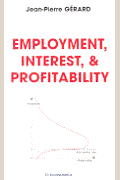As France confronts its most serious economic crisis in post-war history, the French government has been unable to agree on solutions or create programs to stop the collapse of businesses and the rise in unemployment.
Jean-Pierre Gérard has traced the beginnings of France’s current problems to a sharp, worldwide upturn in real interest rates starting in 1982. Noting that the rate increase coincided with a slowdown in job creation and rise in unemployment, Gerard deduced that the increase in real long-term interest rates has two consequences: it creates both greater difficulty in making existing economic activities profitable and more obstacles to creating new businesses.
This book presents the “Gerard Curve,” the first attempt to explain the true relationship between return on capital invested, employment, and long-term interest rates.
Although the idea of a direct correlation is simple, his conclusions are sure to be controversial. Using extensive data from the Banque de France, the book demonstrates that the key to increased employment is a higher return on capital investments-and that government-sponsored efforts, such as work sharing and public spending, are actually drawbacks to creating more jobs. Gérard concludes by suggesting ways economists can grasp the structural factors involved in real interest rates. This book provides a foundation for further studies of economic systems in other industrialized countries.
“Gerard shows by his curve that there is and always will be a direct link between employment, capital, and the cost of money.” Le Monde
Jean-Pierre Gérard is a member of the Banque de France’s Monetary Policy Council and president of the Club des No 1 Mondiaux Français à l’Export, a body of leading French exporters.
Author

